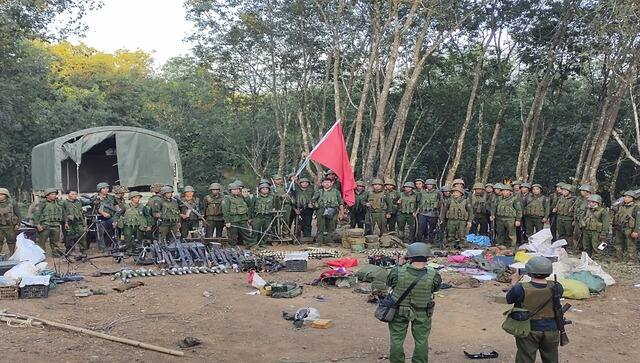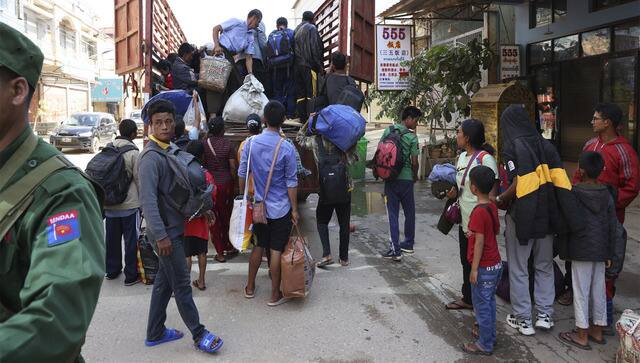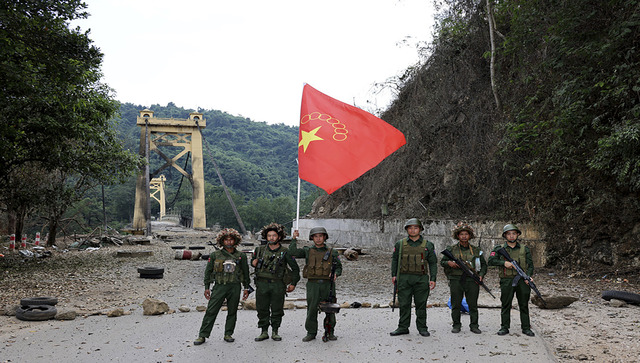The conflict in Myanmar has worried its neighbours, with China calling for a ceasefire in fighting. This comes after a coalition of three ethnic armed groups seized control of several crossings along the Southeast Asian nation’s border with China. Last week, Beijing said it is commencing “combat training activities” on its side of the border with Myanmar. The exercise is aimed at “testing the mobility, border control abilities and firepower capabilities of the military units so that the People’s Liberation Army is ready for any emergency,” Associated Press (AP) reported citing the army newspaper PLA Daily. The ruling junta in Myanmar has so far failed to rein in the attacks by the ethnic minority armed groups which have launched ‘Operation 1027’ in the country’s north Shan State, near China’s border. What is going on in Myanmar? Is the ruling junta losing? Why has it worried China and India? We will try to explain here. Myanmar fighting intensifies The alliance of ethnic minority armed groups – Myanmar National Democratic Alliance Army (MNDAA), Ta’ang National Liberation Army (TNLA) and Arakan Army (AA) – launched coordinated attacks in October across Shan State against the Tatmadaw – the ruling junta’s military. These rebel groups have driven out army and police from several areas along the border with China. The coalition, known as the Brotherhood Alliance, incurred heavy losses on the junta in early November by capturing dozens of military posts and killing the commander of the infamous 99th Light Infantry Division, as per The Conversation report. The groups have also seized at least three towns, including one crucial for overland trade with China. On Saturday (25 November), MNDAA took control of Kyin San Kyawt in Muse district’s Mongko area in Shan State, AFP reported citing the Kokang news. [caption id=“attachment_13436602” align=“alignnone” width=“640”] The Brotherhood Alliance members have seized several military positions. PTI File Photo[/caption] As per AP, Muse has 105-Mile Trade Zone and makes up for Myanmar’s largest volume of trade with China. Last week, nearly 120 trucks carrying goods, parked near the Myanmar-China border, went up in flames, with the junta spokesman Zaw Min Tun blaming the incident on the armed groups, AFP reported. ‘
Operation 1027
’ of the Brotherhood Alliance has triggered several other rebel forces in the country to target junta units across the country, including in the western Chin State. The Karen National Union, another large ethnic force in south-eastern Myanmar, has intensified operations against military posts along the key trade route to the Thai border, reported BBC. The military has struggled to launch a counteroffensive due to the large-scale nature of armed resistance, which has led to its outnumbered soldiers abandoning their military outposts and surrendering. The recent fighting has ramped up Myanmar’s economic woes, which the military has been facing since the 2021 coup. The escalation of the conflict has affected cross-border trade and halted junta’s much-required taxes and foreign exchange, noted AFP. Why is this happening? There has been a rising discontent against Myanmar’s junta rulers. The State Administration Council (SAC) led by the Myanmar armed forces organised a coup in the country in February 2021, ousting the civilian National League for Democracy government. The junta justified its coup by claiming irregularities in the November 2020 elections. However, global observers have denied this, as per The Hindu. Since September 2021, the National Unity Government (NUG) – which The Conversation described as a “shadow government in exile” – has backed a “defensive war” against the ruling military. After the junta’s violent crackdown on largely peaceful protests, the NUG announced the formation of the People’s Defense Forces (PDF), the militias. It also asked other rebel groups to attack the junta. NUG militias have collaborated with many ethnic armed groups in Myanmar, some of which have been fighting the Tatmadaw for years. “Now, every time government troops leave their barracks they face potential attack, causing them to increasingly lean on air power, but further limiting their ability to maintain effective control on the ground," Ronan Lee, Vice-Chancellor Independent Research Fellow, Institute for Media and Creative Industries, Loughborough University London, wrote for The Conversation. Is Myanmar’s junta losing? It is hard to say at this point. “The situation is unprecedented. The mighty Myanmar war machine is on the retreat,” Pratap Heblikar, former special secretary of the Indian government, told The Telegraph. According to Richard Horsey, senior adviser at the International Crisis Group, an independent analysis organisation, the coordinated attacks by rebels “represent the biggest battlefield challenge to the military since its February 2021 coup”. The military has launched airstrikes against the rebels but has so far failed to crush Operation 1027. As per BBC, the military regime could deploy Light Infantry Divisions, a unit known for its atrocities, but it is believed to be reduced since the 2021 coup. “But if the opposition can keep up the pressure, and keep improving its co-ordination, elements within the junta may conclude that they need to start negotiating with their opponents. This is something the coup-leader Min Ang Hlaing has so far refused to consider,” the British broadcaster noted. [caption id=“attachment_13436622” align=“alignnone” width=“640”]
The Brotherhood Alliance members have seized several military positions. PTI File Photo[/caption] As per AP, Muse has 105-Mile Trade Zone and makes up for Myanmar’s largest volume of trade with China. Last week, nearly 120 trucks carrying goods, parked near the Myanmar-China border, went up in flames, with the junta spokesman Zaw Min Tun blaming the incident on the armed groups, AFP reported. ‘
Operation 1027
’ of the Brotherhood Alliance has triggered several other rebel forces in the country to target junta units across the country, including in the western Chin State. The Karen National Union, another large ethnic force in south-eastern Myanmar, has intensified operations against military posts along the key trade route to the Thai border, reported BBC. The military has struggled to launch a counteroffensive due to the large-scale nature of armed resistance, which has led to its outnumbered soldiers abandoning their military outposts and surrendering. The recent fighting has ramped up Myanmar’s economic woes, which the military has been facing since the 2021 coup. The escalation of the conflict has affected cross-border trade and halted junta’s much-required taxes and foreign exchange, noted AFP. Why is this happening? There has been a rising discontent against Myanmar’s junta rulers. The State Administration Council (SAC) led by the Myanmar armed forces organised a coup in the country in February 2021, ousting the civilian National League for Democracy government. The junta justified its coup by claiming irregularities in the November 2020 elections. However, global observers have denied this, as per The Hindu. Since September 2021, the National Unity Government (NUG) – which The Conversation described as a “shadow government in exile” – has backed a “defensive war” against the ruling military. After the junta’s violent crackdown on largely peaceful protests, the NUG announced the formation of the People’s Defense Forces (PDF), the militias. It also asked other rebel groups to attack the junta. NUG militias have collaborated with many ethnic armed groups in Myanmar, some of which have been fighting the Tatmadaw for years. “Now, every time government troops leave their barracks they face potential attack, causing them to increasingly lean on air power, but further limiting their ability to maintain effective control on the ground," Ronan Lee, Vice-Chancellor Independent Research Fellow, Institute for Media and Creative Industries, Loughborough University London, wrote for The Conversation. Is Myanmar’s junta losing? It is hard to say at this point. “The situation is unprecedented. The mighty Myanmar war machine is on the retreat,” Pratap Heblikar, former special secretary of the Indian government, told The Telegraph. According to Richard Horsey, senior adviser at the International Crisis Group, an independent analysis organisation, the coordinated attacks by rebels “represent the biggest battlefield challenge to the military since its February 2021 coup”. The military has launched airstrikes against the rebels but has so far failed to crush Operation 1027. As per BBC, the military regime could deploy Light Infantry Divisions, a unit known for its atrocities, but it is believed to be reduced since the 2021 coup. “But if the opposition can keep up the pressure, and keep improving its co-ordination, elements within the junta may conclude that they need to start negotiating with their opponents. This is something the coup-leader Min Ang Hlaing has so far refused to consider,” the British broadcaster noted. [caption id=“attachment_13436622” align=“alignnone” width=“640”] Members of the Myanmar National Democratic Alliance Army ethnic armed organization herd soldiers of the army battalion and their family members who surrendered to them two days earlier on to a truck, on 14 November 2023 in Kokang Self-Administered Zone in Myanmar’s northern Shan state. AP File Photo[/caption] Experts believe the junta could widen its crackdown and use oppressive tactics to tackle the rebels. “While anti-junta forces are understandably enthusiastic following the dramatic early successes of Operation 1027, military collapse or regime capitulation seem far off,” Horsey told The Telegraph. “More likely is that the regime will double down on brutal efforts to gain the upper hand on the battlefield, including scorched-earth tactics and indiscriminate bombing and shelling.”
Members of the Myanmar National Democratic Alliance Army ethnic armed organization herd soldiers of the army battalion and their family members who surrendered to them two days earlier on to a truck, on 14 November 2023 in Kokang Self-Administered Zone in Myanmar’s northern Shan state. AP File Photo[/caption] Experts believe the junta could widen its crackdown and use oppressive tactics to tackle the rebels. “While anti-junta forces are understandably enthusiastic following the dramatic early successes of Operation 1027, military collapse or regime capitulation seem far off,” Horsey told The Telegraph. “More likely is that the regime will double down on brutal efforts to gain the upper hand on the battlefield, including scorched-earth tactics and indiscriminate bombing and shelling.”
Impact on India and China Whatever happens in Myanmar holds specific concerns for India and China. The people displaced by the recent fighting in the conflict-ridden nation are already seeking refuge in India’s Mizoram. Around 1,500 nationals of Myanmar reached Mizoram’s Champhai district on 13 November after an intense gunfight between the Myanmar Army, and pro-democracy militias in the Chin State. Around 39 soldiers of the Myanmar military also fled to Mizoram but were later sent back by India, reported The Hindu. The Mizoram Police said earlier that about 5,000 people fleeing violence in Myanmar have crossed into Mizoram. Over 332,000 people have been displaced in Myanmar since the recent conflict erupted in October, as per the United Nations. External Affairs Ministry spokesperson Arindam Bagchi said on 17 November that India is concerned over the rising violence in Myanmar. “We reiterate our call for the return of peace, stability and democracy in Myanmar. As a result of the fighting [at] Rihkhawdar area in Chin State, opposite Zokhawthar in Mizoram on the India-Myanmar border, there has been movement of Myanmar nationals to the Indian side. We are deeply concerned with such incidents close to our border,” Bagchi was quoted as saying by News18. China, which has its own interests in Myanmar, may have green-lit the recent fighting amid perceived strain in ties with the ruling junta. As per The Conversation report, the Brotherhood Alliance members depend on China for arms and it is “unlikely” that they launched an operation without Beijing’s nod. The Asian giant has been a global ally of Myanmar’s junta, but also had close ties with the country’s ousted de facto leader, Aung San Suu Kyi. Beijing has also maintained close links to many of Myanmar’s ethnic armed groups, the report added. China and Myanmar also have trade ties, with the latter relying heavily on the Asian giant for importing manufactured goods and exporting agricultural products. The recent conflict has halted Myanmar’s land trade with China. “Billions of dollars’ worth of business is transacted legally and illegally. The closure of the borders is hurting Chinese business interests,” the Indian government’s former special secretary Heblikar told The Telegraph. Any unrest in Myanmar’s border areas is a “constant irritant” to China, making it concerned about the conflict spilling over the border, noted AP. “China is highly concerned about the conflicts in Myanmar and has urged all sides to cease fire and start peaceful dialogues to prevent the situation from escalating further,” the PLA Daily said recently. The PLA also vowed to “safeguard border security and protect the lives and property of people living in the border areas.” Last week, China asked its citizens to leave northern Myanmar “as soon as possible” and to avoid the fighting. Beijing’s envoy also met top officials in Myanmar’s capital recently to discuss border stability. Despite expressing apprehension about the 2021 coup, Beijing backed the junta rule. “Now, strategic reversals, nationwide territorial losses and economic decline mean momentum has strongly shifted away from Myanmar’s junta. China’s leadership may have read the situation better than most, recognising the junta may now be in a death spiral,” Lee wrote for The Conversation.
)